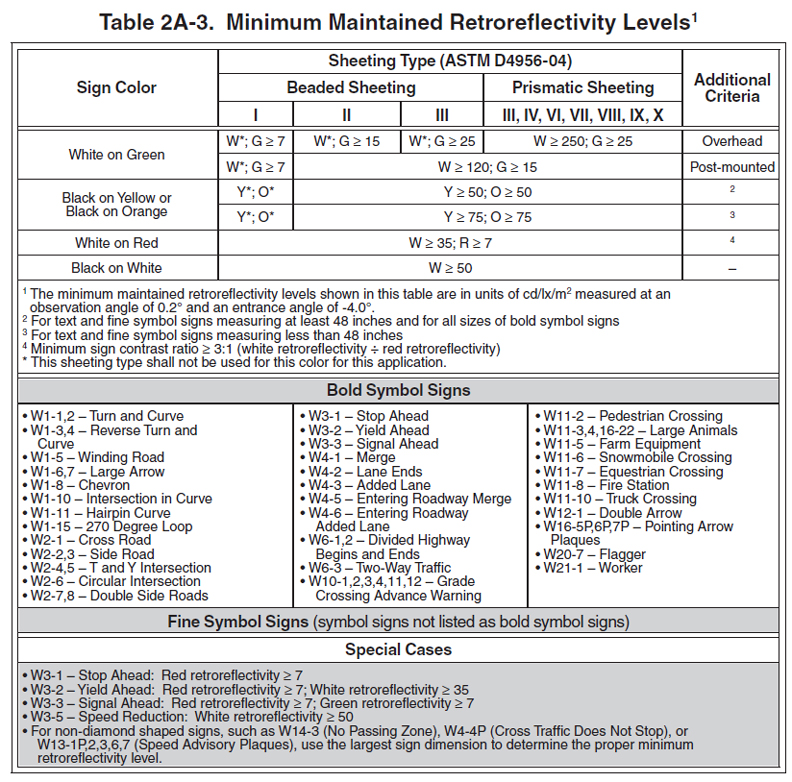The following chart indicates the minimum requirements for retro reflective sheeting and tape required to meet the 2009 MUTCD Code for road signs that fall under the regulations of the Federal Highway Administration (FHWA) and the Manual of Uniform Traffic Control Devices (MUTCD).
Compliance dates:
- January 22,2012 – Section 2A.08 – Implementation and continued use of an assessment or management method that is designed to maintain traffic sign retro-reflectivity at or above the established minimum levels.
- January 22, 2015 – Section 2A.08 – Replacement of regulatory, warning, and post-mounted guide (except street name) signs that are identified using the assessment or management method as failing to meet the established minimum levels.
- January 22, 2018 – Section 2A.08 – Replacement of street name signs and overhead guide signs that are identified using the assessment or management method as failing to meet the established minimum levels.
Quoted MUTCD standards:
Section 2A.08 Maintaining Minimum Retroreflectivity
Support:
01 Retroreflectivity is one of several factors associated with maintaining nighttime sign visibility
(see Section 2A.22).
Standard:
02 Public agencies or officials having jurisdiction shall use an assessment or management method that is
designed to maintain sign retroreflectivity at or above the minimum levels in Table 2A-3.
Support:
03 Compliance with the Standard in Paragraph 2 is achieved by having a method in place and using the method
to maintain the minimum levels established in Table 2A-3. Provided that an assessment or management method
is being used, an agency or official having jurisdiction would be in compliance with the Standard in Paragraph 2
even if there are some individual signs that do not meet the minimum retroreflectivity levels at a particular point
in time.
Guidance:
04 Except for those signs specifically identified in Paragraph 6, one or more of the following assessment or
management methods should be used to maintain sign retroreflectivity:
A. Visual Nighttime Inspection—The retroreflectivity of an existing sign is assessed by a trained sign
inspector conducting a visual inspection from a moving vehicle during nighttime conditions. Signs
that are visually identified by the inspector to have retroreflectivity below the minimum levels should
be replaced.
B. Measured Sign Retroreflectivity—Sign retroreflectivity is measured using a retroreflectometer. Signs
with retroreflectivity below the minimum levels should be replaced.
C. Expected Sign Life—When signs are installed, the installation date is labeled or recorded so that the
age of a sign is known. The age of the sign is compared to the expected sign life. The expected sign life
is based on the experience of sign retro-reflectivity degradation in a geographic area compared to the
minimum levels. Signs older than the expected life should be replaced.
D. Blanket Replacement—All signs in an area/corridor, or of a given type, should be replaced at specified
intervals. This eliminates the need to assess retro-reflectivity or track the life of individual signs. The
replacement interval is based on the expected sign life, compared to the minimum levels, for the
shortest-life material used on the affected signs.
E. Control Signs—Replacement of signs in the field is based on the performance of a sample of control
signs. The control signs might be a small sample located in a maintenance yard or a sample of signs in
the field. The control signs are monitored to determine the end of retro-reflective life for the associated
signs. All field signs represented by the control sample should be replaced before the retro-reflectivity
levels of the control sample reach the minimum levels.
F. Other Methods—Other methods developed based on engineering studies can be used.
Support:
05 Additional information about these methods is contained in the 2007 Edition of FHWA’s “Maintaining Traffic
Sign Retroreflectivity” (see Section 1A.11).
Option:
06 Highway agencies may exclude the following signs from the retro-reflectivity maintenance guidelines described
in this Section:
A. Parking, Standing, and Stopping signs (R7 and R8 series)
B. Walking/Hitchhiking/Crossing signs (R9 series, R10-1 through R10-4b)
C. Acknowledgment signs
D. All signs with blue or brown backgrounds
E. Bikeway signs that are intended for exclusive use by bicyclists or pedestrians
